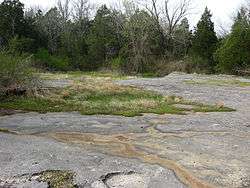Calcareous glade
A calcareous glade is a type of ecological community that is found in the central eastern United States. Calcareous glades occur where bedrock such as limestone occurs near or at the surface, and have very shallow and little soil development. Because of the shallow soil and the extreme conditions created by it, trees are often unable to grow in the glades. This creates a habitat that is usually sunny, dry, and hot. Calcareous glade vegetation is more similar to that of a desert habitat than a grassland, being dominated by small spring annuals with occasional geophytic or succulent perennials.

The usage of the words "glades" and "barrens" to describe dry, rocky communities in the United States is not uniform, and the terms are often used interchangeably.[1] Calcareous glade communities can intergrade with dry rocky prairies, particularly in sloping habitats. Due to their unsuitability for agriculture, glade communities have survived to the present day at a higher rate than deeper-soil prairie communities.[1]
Interior Low Plateau glades
The Interior Low Plateau is a region in the Upper South that is known for its calcareous glade communities. This region is centered in Tennessee and Kentucky, and extends into northern Alabama, and southern Illinois, southern Indiana, and southern Ohio. These glades are best developed in the area of the Central Basin (or Nashville Basin) in Tennessee, where they are geographically widespread and harbor high levels of endemism. Outside of the Central Basin, calcareous glades are found in lower numbers throughout the Interior Low Plateau, and species endemism is greatly reduced. Glades in the Interior Low Plateaus are characterized by species such as one-flower gladecress (Leavenworthia uniflora), limestone skullcap (Scutellaria parvula), widow's-cross stonecrop (Sedum pulchellum), poverty dropseed (Sporobolus vaginiflorus) and glade violet (Viola egglestonii).[2]
Central Basin cedar glades
The limestone glades of the Central Basin in Tennessee are often called "cedar glades". The name comes from the abundance of eastern red cedar (Juniperus virginiana) that occurs on the margins of the glades or in cracks in the bedrock where the roots can gain a foothold.
Many of the characteristic plants that grow in the limestone glades of the Central Basin are endemics that occur nowhere else, or disjunct populations of plants that are widespread in the prairies of the central U.S.[3] Some species with highly restricted ranges that occur in the glades of the Central Basin include the Tennessee coneflower (Echinacea tennesseensis), Pyne's ground plum (Astragalus bibullatus), leafy prairie clover (Dalea foliosa), Tennessee milkvetch (Astragalus tennesseensis), Nashville breadroot (Pediomelum subacaule), and limestone fameflower (Phemeranthus calcaricus).

These glades can be saturated with water in the winter and spring, leading to "xerohydric" (dry/wet alternating) conditions.[4]
Threats to the cedar glades
The central basin (or Nashville Basin) of Tennessee is one of the largest areas containing limestone glades. Because of the rapid growth of metropolitan Nashville and the surrounding cities of Murfreesboro and Lebanon, many of the limestone glades have been destroyed by development. The State of Tennessee and the Nature Conservancy have established a number of parks and preserves to protect important plant populations. Cedars of Lebanon State Park in Wilson County and Long Hunter State Park in Davidson County both protect substantial limestone glade ecosystems.
Ozark Mountains glades
Calcareous glades are well developed in the Ozark Mountains. In Missouri, the majority of these glades are found on dolomitic limestones, with less than 1% formed from carbonate limestone.[1] Species indicative of Ozarkian calcareous glade communities include Cheilanthes feei, Echinacea simulata, Heliotropium tenellum, Isoetes butleri, Oenothera macrocarpa, and Ophioglossum engelmannii.[1] In Missouri, Physaria filiformis is a species restricted to calcitic limestone glades.[1]
Ridge and Valley glades
The Ridge and Valley region, which extends north from Pennsylvania south to Alabama, has significant calcareous glade communities.[5] These glades often have dolomitic soils, resulting in a high magnesium content (in contrast to the glades of the Nashville Basin). In Virginia, these glades provide habitat for rare magnesiophiles such as Addison's leatherflower (Clematis addisonii), tall larkspur (Delphinium exaltatum), smooth coneflower (Echinacea laevigata), and glade wild quinine (Parthenium auriculatum).[6]
At the southern end of the Ridge and Valley in Alabama in Bibb County, species endemism of glade communities peaks. This area, known as a Ketona Dolomite Outcrops, was first recognized as ecologically significant in 1992. Since its discovery, eight new plant taxa to science have been described from this region, in addition to the 60 species of conservation concern found in or around this community.[7] Endemic species of this area include Castilleja kraliana, Dalea cahaba, Liatris oligocephala, Lithospermum decipiens, and Spigelia alabamensis.
References
- Yatskievych, George (1999). Flora of Missouri, Volume 1. Missouri Botanical Garden Press.
- Jones, Ron (2005). Plant Life of Kentucky. The University Press, Kentucky. pp. 14–15.
- Cedar Glades Brochure Center For Cedar Glade Studies
- Glades Archived 2018-02-13 at the Wayback Machine Austin Peay State University Herbarium
- Bartgis, Rodney (1993). "The Limestone Glades and Barrens of West Virginia". Castanea. 58 (2): 69–89. JSTOR 4033660.
- Limestone / Dolomite Woodlands and Barrens The Natural Communities of Virginia Classification of Ecological Groups and Community Types
- Vascular Flora of Ketona Dolomite Outcrops in Bibb County, Alabama, by Jim Allison and Timothy Stevens